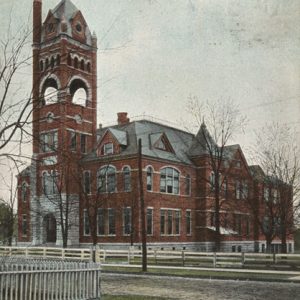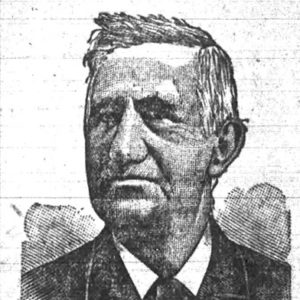calsfoundation@cals.org
Frederick Kramer (1829–1896)
Frederick Kramer emigrated in 1848 from Prussia to the United States, settling in the 1850s in Little Rock (Pulaski County), where he became a wealthy businessman and a participant in the city’s civic life. He served two terms as an alderman (1869–1872) and four terms as mayor (1873–75, 1881–1887). Also, he was elected to Little Rock’s first school board in 1869 and served continuously on the board until 1894, most years as the board’s president. He was a member, and often an officer, in social and service organizations ranging from the Casino Club, of which he was president, to the Masons, in which he rose to the highest ranks.
Frederick Kramer was born on December 22, 1829, in or near Halle, a university town on the Saale River in Prussia’s Saxony Province. He moved to the United States in 1848. While living in Boston, Massachusetts, in 1852, he enlisted in the U.S. Army’s Seventh Cavalry E Company (his enlistment record noted his occupation as “painter”). He was stationed at Fort Arbuckle in Indian Territory (present-day Oklahoma).
Kramer first came to Little Rock in 1852 as he traveled to his assigned post in Indian Territory. Likely, he spent some service time at the Little Rock Arsenal. In April 1857, as his five-year enlistment was nearing an end, he filed papers in Pulaski County declaring his intention to apply for U.S. citizenship. On June 30, he married Adeline (sometimes spelled Adaline) Reichardt, who had emigrated to Pulaski County from Asch (As), in Austria’s Bohemia, in 1853. They had nine children, six of whom survived to adulthood.
On July 27, 1857, Kramer was officially mustered out of the army, but six weeks later, on September 12, he reenlisted to be a “cabinet maker” at the Little Rock Arsenal. His second enlistment ended in November 1859. A month later, he was granted U.S. citizenship, and he began a new career as a grocer, opening a store with Ferdinand A. Sarasin, another German immigrant.
After the start of the Civil War in 1861, Sarasin and Kramer closed their store so that Sarasin could join the Confederate army; Kramer, who also supported the Southern cause, did not. In 1862, Kramer operated a tannery with John Geyer, a German-immigrant businessman. In November 1863, after the Union army had occupied Little Rock, Kramer opened a grocery store with Charles Miller, a German immigrant who had been a Confederate soldier. (Miller’s wife was Fredericka Reichardt, sister of Adeline Reichardt Kramer.)
The Kramer and Miller Grocery Store and Bakery, located at 3rd and Main streets, prospered during and after the war. In 1867, the owners took on a new partner, Charles Penzel, a German immigrant who had been badly wounded as a Confederate soldier. Penzel’s sister was married to Christopher Reichardt, brother of Fredericka and Adeline.
After the war, Kramer involved himself in local affairs. For example, he volunteered to serve in the Defiance Hook and Ladder Company No. 1 and joined the Little Rock Chamber of Commerce when it formed in January 1867. He also became a Mason, ultimately achieving the rank of 33rd Degree Mason and serving as the secret society’s statewide treasurer.
Kramer ran unsuccessfully for the Little Rock City Council in January 1867. In February 1869, nominated by the Republican Party, he won a seat on the newly created Little Rock School Board. Later that year, again nominated by the Republicans, he was elected Ward 1 alderman. He was reelected alderman in 1870 as the nominee of the Minstrel faction of the Republican Party (aligned with the national regular Republican leadership).
In a factional fight over who would be president of the Little Rock City Council after the 1871 election, Kramer was attacked by the Brindletail faction of the Republican Party (aligned with the Liberal Republican movement) and by the Arkansas Gazette, the voice of the Democratic Party. The Gazette questioned his integrity and urged its readers to boycott Kramer’s grocery store. Perhaps because of that bruising battle, Kramer did not seek reelection to the city council in 1872. Instead, he dissolved his grocery store partnership and took a five-month trip to Germany. He returned to Little Rock in time to be reelected in December 1872 to another three-year term on the school board.
After a year out of municipal office, he was nominated unanimously by the Republican Party to be mayor. In the November 1873 election, he was opposed by Herbert H. Rottaken, a fellow Prussian who had served in the Union army but nevertheless was supported by the Arkansas Gazette and, more quietly, by the Democratic Party. Kramer easily won the election. His first term as mayor came at an especially difficult time. First, a national recession had recently hit Arkansas, making Little Rock’s fraught financial situation even worse. Then, in April 1874, the Brooks-Baxter conflict broke out with Little Rock at its center.
As mayor, Kramer focused on reducing city expenditures and on law enforcement, especially efforts to suppress “faqirs,” swindlers who were preying on visitors. He rode with the city police on raids, made arrests, and, when the elected judge was absent, served as municipal court judge. During the Brooks-Baxter dispute, Kramer remained neutral.
After the Democratic Party regained power in 1874, municipal elections were scheduled for April 1875, and as the election approached, Kramer—although nominated for mayor in 1873 by the Republican Party—sought the Democratic Party’s nomination for the office. Instead, it chose John G. Fletcher as its candidate. Kramer was then nominated for mayor by the Republican Party, but he refused the nomination and supported the Democratic Party ticket.
Although his change of affiliation from the Republican to the Democratic Party was abrupt, it was understandable to many. Starting in February 1869, Kramer had repeatedly stated that he was not a Republican. He professed to hold the “most conservative sentiments” and explained to the Arkansas Gazette in 1871 that he had accepted Republican support because “he was but one man and was utterly powerless to do any good, that by keeping with the ring he could do a little for the people.” When the Democratic Party was re-empowered, he returned to his true political home.
After leaving office in April 1875, Kramer continued his business career, managing his real estate and other investments, plus taking on part-time positions such as president of the Little Rock Cotton Warehouse Company and vice president of Merchant’s Bank. He escalated his involvement in civic activities and continued his leadership of the school board. Also, he remained active in the Democratic Party and in 1878 ran unsuccessfully for the Arkansas General Assembly as one of the party’s nominees.
In April 1881, he was the Democratic Party’s nominee for mayor. Although an underdog in the contest against William G. Whipple, a highly regarded Republican, he won the election with a three-vote margin. Kramer was reelected in 1883 in a re-match with Whipple, winning more comfortably with a margin of over 300 votes. In both elections, Kramer was supported by the Arkansas Gazette, which rejoiced in his success, and was opposed by the Arkansas Democrat, whose editors thought highly of Whipple.
In the 1885 election, he was opposed by a fellow Democrat, Judge R. W. Martin, who was endorsed by the Gazette. Kramer’s candidacy this time was backed by the Arkansas Democrat and most of the city’s prominent business leaders. He won with fifty-six percent of the vote.
As mayor from 1881 to 1887, Kramer focused his attention on law enforcement and city finances. Exercising his powers as mayor, he not only hired, disciplined, and fired police officers, but he also made arrests, often to enforce laws prohibiting public drunkenness and other forbidden public behavior.
Even more critical were Kramer’s efforts to secure revenues to pave streets, build bridges, and tame creeks within Little Rock’s expanding city limits. He tried to keep operating expenditures low through strict oversight and pushed for limited new taxes to pay for city improvements, often pointing out that if people wanted the benefits of a modern city, they had to pay for them.
According to Carolyn LeMaster’s definitive study of Jews in Arkansas history, Kramer was a founding member of the B’nai Israel congregation in Little Rock, which formed in 1866. However, the Kramer family was closely associated with both Little Rock’s Christ Church (Episcopal) and First Lutheran Church.
Kramer, who died on September 8, 1896, is buried at Oakland-Fraternal Cemetery in Little Rock, his grave marked by a large obelisk on which are inscribed the following words: “True to his friends, true in every trust imposed upon him, and true to himself.” The Gazette eulogized, “The city has no better citizen. Far-seeing, public-spirited, generous to the needy, and kind to everybody.” Soon after his death, the Little Rock School Board named its new school, located on Sherman Street, the Kramer School. Among his grandchildren was Little Rock merchant Frederick Kramer Darragh, father of businessman and philanthropist Frederick Kramer Darragh Jr.
For additional information:
“Death of Hon. Frederick Kramer.” Arkansas Gazette, September 9, 1896, p. 4.
Durning, Dan. “Frederick Kramer: Little Rock’s Last Reconstruction Mayor.” Pulaski County Historical Review 67 (Winter 2019): 102–120.
Hempstead, Fay. Historical Review of Arkansas: Its Commerce, History, and Modern Affairs, Vol. 2. Chicago: Lewis Publishing Co., 1911.
———. A Pictorial History of Arkansas from Earliest Times to 1890. St. Louis, MO: N. D. Thompson Publishing Co., 1890.
LeMaster, Carolyn Gray. A Corner of the Tapestry: A History of the Jewish Experience in Arkansas, 1820s–1990s. Fayetteville: University of Arkansas Press, 1994.
Dan Durning
Birch Bay, Washington
 Business, Commerce, and Industry
Business, Commerce, and Industry Civil War through Reconstruction, 1861 through 1874
Civil War through Reconstruction, 1861 through 1874 Politics and Government
Politics and Government Kramer School
Kramer School  Frederick Kramer
Frederick Kramer 




Im doing some writing about the founding members of First Lutheran Church, Little Rock, and I have verified that the same Frederick Kramer described in the EOA entry is one of those founders. (Yes, the same one who was a Mason and who was a founder of B’nai Israel.) On December 13, 1868, Frederick Kramer was one of twenty-four people who met in the house of Charles Miller to begin a Lutheran congregation in Little Rock. The next spring Kramer’s father-in-law, John Martin Reichardt, was elected chairman of the congregation, and Kramer’s business partner, Charles Petzel, was elected secretary. The first services of the congregation (First Lutheran Church) were held on the third floor of the Kramer and Miller Grocery Store and Bakery. Elbert Kramer, son of Frederick and Adelina Kramer, was the first child baptized in the new Lutheran congregation: he was born April 29, 1869, was baptized July 29, 1869, died March 8, 1870, and is buried at Mount Holly Cemetery. I wonder if any other person anywhere in the country helped to found a citys first synagogue and that same citys first Lutheran church in under three years.